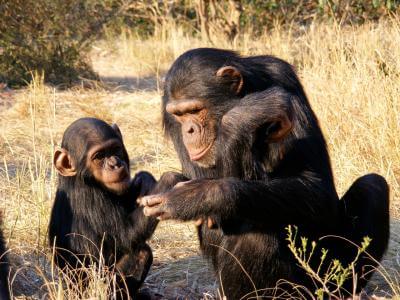Chimpanzees’ personality traits are linked to the anatomy of specific brain structures, according to researchers at Georgia State University, The University of Texas MD Anderson Cancer Center and University of Copenhagen.
The findings, published online in the journal NeuroImage in August, reveal that both gray- matter volumes of various frontal cortex regions and gray-matter volume asymmetries (larger right versus left or vice versa) are associated with various personality traits. The results suggest the frontal cortex and asymmetries in this region of the brain play an important role in the neurobiological foundation of broad personality traits.
“Our results confirm the importance of neuroscientific approaches to the study of basic personalities and suggest that when compared to humans many of these associations are comparable in chimpanzees,” said Robert Latzman, assistant professor in the Department of Psychology at Georgia State.
The researchers studied 107 chimpanzees’ brains using magnetic resonance image (MRI) scans and also assessed each chimpanzee’s personality by using a 41-item personality questionnaire. They found chimpanzees who were rated as higher for the personality traits of openness and extraversion had greater gray-matter volumes in the anterior cingulate cortex in both hemispheres of the brain. Chimpanzees who were rated as higher on dominance had larger gray-matter volumes in the left anterior cingulate cortex and right prefrontal cortex. Chimpanzees who rated higher on reactivity/unpredictability had higher gray-matter volumes in the right mesial prefrontal cortex.
All chimpanzees received MRI scans during their annual physical examination. For the personality questionnaire, the chimpanzees were rated by staff members who had worked with the animals for an extended period and felt they had enough experience for an accurate rating. Each item consisted of a single trait with a behavioral definition and a scale ranging from “least descriptive of the chimpanzee” to “most descriptive of the chimpanzee.” The instrument consisted of five dimensions: extraversion, openness, agreeableness, dominance (opposite to the human trait of neuroticism) and reactivity/undependability (a dimension that includes content from the opposite side of the human traits of conscientiousness, agreeableness and extraversion).
Previous studies by this group suggest the existence of largely similar personality traits in humans and chimpanzees, but until this study, researchers had not explored the neuroanatomical basis of these traits in nonhuman primates.
If our reporting has informed or inspired you, please consider making a donation. Every contribution, no matter the size, empowers us to continue delivering accurate, engaging, and trustworthy science and medical news. Independent journalism requires time, effort, and resources—your support ensures we can keep uncovering the stories that matter most to you.
Join us in making knowledge accessible and impactful. Thank you for standing with us!

